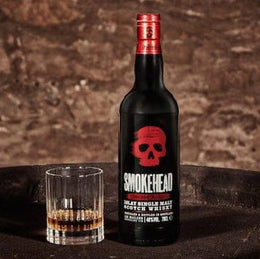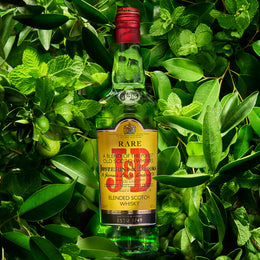
|
Felipe is an award-winning London-based whisky writer, tastings host, drinks competitions judge, and author. He is also a musician and co-founder of The Rhythm and Booze Project, a duo that fuses live music and whisky through gigs, tasting events and multimedia. |
If you aren’t a big whisky drinker, there’s still plenty of reasons to buy a bottle of Scotch whisky. It might be as a present, to keep the liquor cabinet stocked, or just because you enjoy the odd tipple of something tasty on a regular basis. Sometimes, finding a bottle can be easy. Perhaps you know what brand to buy, or a friendly shop assistant guides you in the right direction.
But wouldn’t it be nice to know what to look for when buying a whisky bottle?


Here’s a brief guide for helping you do just that.
This little primer is aimed at eager beginners who want to know more about finding and purchasing bottles using their own judgement, and to start exploring the wide and wonderful world of scotch whisky. However, it also works for anyone who wants to be able to navigate the sometimes confusing information that can be found on whisky bottle labels. However, I also make the disclaimer that there’s plenty of delicious exceptions to some of the points I make below.
So here’s what to watch out for:
1. Is there an age statement?
If a whisky doesn’t have an age statement on it, this probably means the liquid is anywhere between 3 to 9 years old. While I have tried many superb young whiskies with no age statement on the bottle (these are called No Age Statement, or NAS whiskies), I also find a lot of NAS bottles are still unremarkable and/or overpriced. Unless you are pretty sure that the bottle of young whisky in front of you is good, I’d tend towards something that’s 10 years or older.
2. What type of Scotch whisky is it?
There’s 5 different categories of Scottish whisky, and each category boasts some phenomenal choices. However, some are more consistent in quality than others. Here’s the different types and what that means:
Single Malt: This is whisky made from 100% malted barley from one single distillery. Single malts are feted (with justification) as being the highest quality Scotch whisky compared to the other types.
Blended malt: This is whisky made from 100% malted barley produced in two or more distilleries.
Single Grain: Under scotch whisky law, if a whisky isn’t made from malted barley, it legally is defined as ‘grain’, which 99% of the time means corn (maize) or wheat. I also think this is an underrated category, as grain is typically seen as 'inferior'.
Blended Grain: Like with the blended malt, this is whisky made from wheat or corn that has been produced at two or more distilleries.
Blended: A mix of malt whisky and grain whisky from two or more distilleries, this is probably the most common type of whisky in the world. Where grain whisky is easy to produce in industrial quantities, the quality isn’t necessarily great so adding a little malt whisky softens the nasty bitterness and makes it an easier drink, in theory.
3. Is there information about maturation?
99% of Scotch whisky is matured in casks that came from other drinks industries, and sometimes a bottle will include some information about its maturation history.
‘American oak’ will almost always mean ex-bourbon, and which tends towards a lighter, creamier profile. ‘Sherry casks’, which includes the terms ‘PX’, ‘Fino’, and ‘Oloroso’, is a bit of a nebulous term these days (here’s a great article explaining why), but this will probably mean fruitier and tannic flavors. Sometimes other casks come into play (such as port or wine), these also bring fruity elements.
Also, if you see the words ‘First fill’, this is usually a good thing.
4. Are there tasting notes?
A lot of Scotch whisky bottles include tasting notes describing its contents (usually divided into ‘nose’ and ‘taste’), and serves as a passable guide for what to expect. The more detail on the tasting notes the better in my opinion.
Also, if a whisky is smoky, you’ll often see the words ‘peat’, or ‘smoke’ on the bottle highlighting this quality. The whisky will probably have a meatier, heavier profile, and will include various meat and fish words in the tasting notes, or the word ‘bonfire’.
5. What is the alcohol strength?
If a whisky is between 40-50% alcohol by volume (ABV) this means that water was added before the whisky was bottled. 51%+, usually means that the whisky is ‘cask strength’, that it was bottled without adding extra water. Keep in mind that many older cask strength whiskies (25 years+) might still be cask strength even if the ABV dips below 50%.
A higher alcohol strength isn’t an indicator of quality, but I do find that cask strength whisky tends to be consistently good, though I recommend adding water to your glass to counter the strong alcohol content!
I do stress though that alcohol content is not a great indicator of quality. There’s loads of great whisky bottled at 40%!
6. Is it artificially colored or chill-filtered?
Most Scotch whiskies, even the best stuff, is artificially colored, and a lot of it is also chill filtered (chill filtering applies to whiskies below 46% ABV). Adding caramel coloring (e150) to the whisky makes it look darker, and therefore more appealing. However, it’s not a great quality indicator (one of my favourite go-to whiskies, Lagavulin 16, is artificially coloured). Here’s an article that covers the issues around coloring nicely and here’s an excellent, if a little geeky, approach on the subject. Chill-filtration is another process that affects cosmetics more than flavor, but I think it's a more contentious subject than coloring (have a look at another great Scotchwhisky.com article on chill filtering here).
Unless a bottle says that there’s no artificial coloring in the contents, it’s probably artificially colored. Don’t worry about this issue too much but when it comes to chill filtering, in my opinion it doesn’t hurt to be a little snooty and to go for a bottle that clearly states that there’s no chill filterering involved.
7. Dispelling the region myth
This isn’t something that is particularly relevant looking at a bottle, but is worth knowing.
Historically, Scotch whisky has been marketed as a product that comes from 4-6 different ‘regions’ (Highlands, Lowlands, Speyside, Campbeltown, Islands, etc.), and that each region has its own flavor profile. Often, Scotch whiskies are grouped into these categories in shops.
Quite frankly, speaking about whisky flavors in terms of their region makes no sense these days. Each whisky distillery is different and has different production and maturation methods. Often one single distillery showcases a wide variety of flavors just within their own releases. These differences are far more important than any overall ‘regional’ taste profile. Beware the shop assistant or brand ambassador that talks about whisky in this way. But also forgive them, because they probably don’t know better themselves!
By Felipe Schrieberg
Felipe is a London-based whisky writer, musician, tastings host, drinks competitions judge, and author. He writes for internationally renowned publications such as Forbes, Whisky Magazine and The Whiskey Wash. He has been awarded the Icons of Whisky Communicator of the Year award at Whisky Magazine's 2022 World Whiskies Awards.
He is the co-founder of The Rhythm and Booze Project, a duo fusing live music and whisky through gigs, tasting events, and multimedia. His past projects encompass performances at the Edinburgh Fringe of the band's own show Two Guys, Three Drams which combined live blues with whisky tasting, and building the world's first bass drum made from an entire Scotch whisky cask with a barrel of Lagavulin.
He is also a judge for the World Whiskies Awards and The Independent Bottlers Challenge. Through his online tastings hosted at The Virtual Whisky Masterclass, he has welcomed over 3,000 guests across 250+ tasting events.
His first book, London Cocktails, is now available worldwide. Follow him on Twitter/Instagram @schriebergfr, or at www.felipeschrieberg.com






